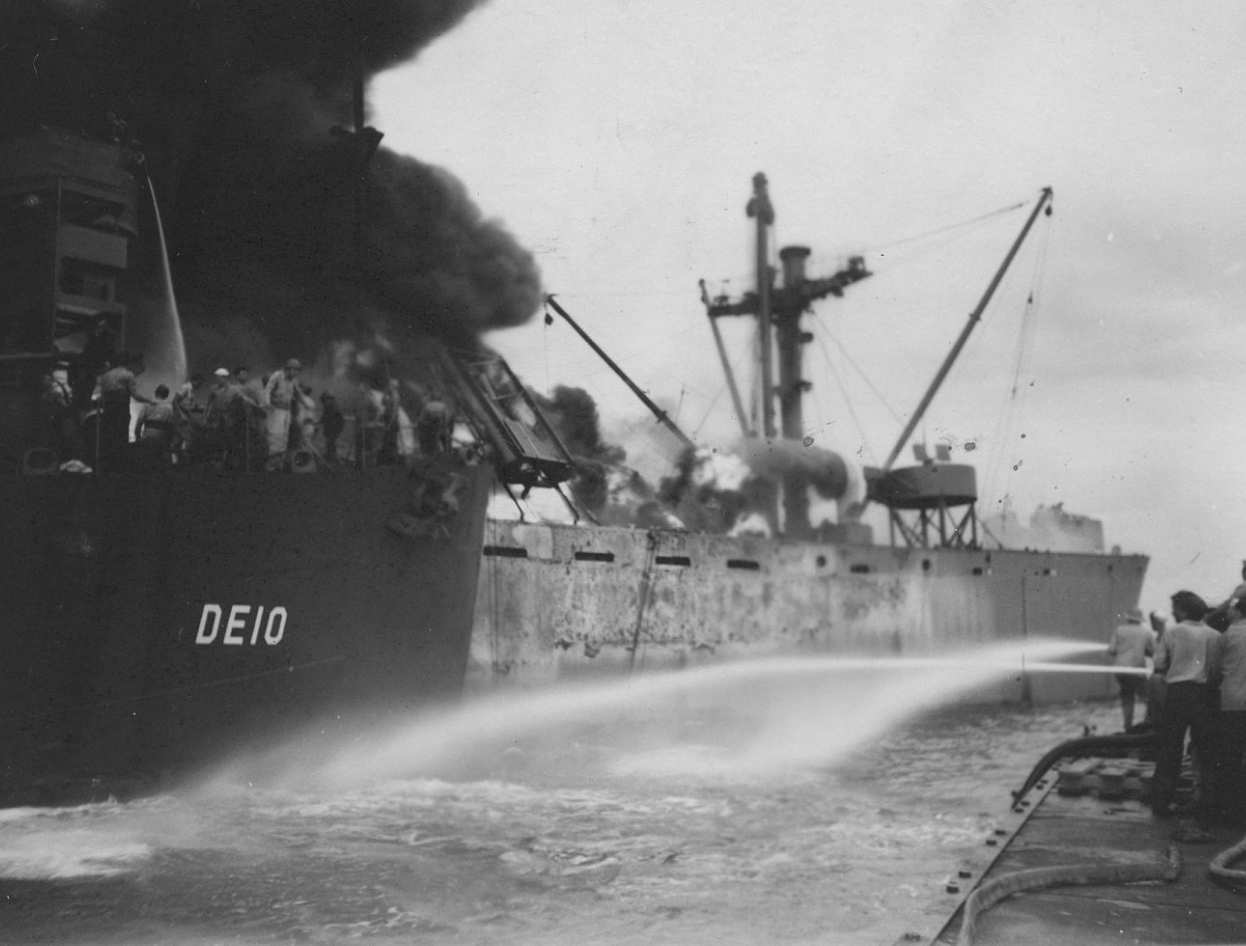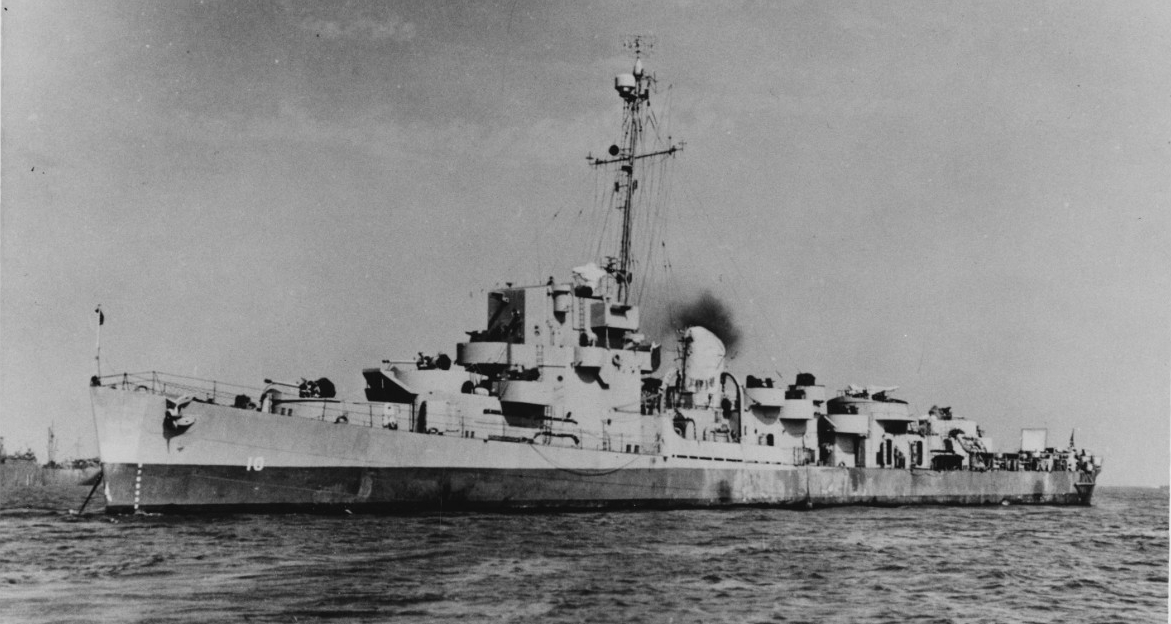Bebas (DE-10)
1943–1945
Gus George Bebas, born on 24 February 1914 in Chicago, Illinois, received his commission as an ensign in the U.S. Naval Reserve on 26 May 1938. Bebas attended the Northwestern University School of Engineering, earning a B.S. degree in commerce in 1939. While at Northwestern, Bebas served in the Naval Reserve Officer Training Corps at that institution, and trained on board heavy cruiser Wichita (CA-45) between 16 and 30 June 1939. His commission as an ensign terminated under honorable conditions on 22 January 1940, Bebas enlisted the following day as a seaman second class. He completed one stint of elimination flight training at Naval Reserve Aviation Base Glenview, Illinois, between 14 February and 14 March 1940, and a second between 15 December 1940 and 15 January 1941. His enlistment terminated under honorable conditions on 19 February, he received appointment as an aviation cadet, USNR, and reported for training at Naval Air Station (NAS), Pensacola, the following day.
Transferred to NAS Miami for “further active duty undergoing training” on 4 August 1941, Bebas was appointed naval aviator (heavier than air) No. 8779 on 5 September. Released from active duty involving training on 25 September, he received promotion to ensign, A-V(N), USNR, the following day. Assigned to the Advanced Carrier Training Group, Atlantic Fleet, on 26 September, Bebas reported to the Curtiss SBC-3-equipped Bombing Squadron (VB) 8, part of the Hornet (CV-8) Air Group, two days before Christmas of 1941. When Hornet sailed for the Pacific in March 1942, Bebas and his squadron were serving on board, ultimately re-equipping with the Douglas SBD-3 Dauntless as that dive bomber became available in quantity.
During the first day of the Battle of Midway, 4 June 1942, Bebas flew with VB-8 in the first strike from Task Force 16, but his squadron did not locate the enemy, flying to Midway and thence, after refueling, back to the ship. The next afternoon, 5 June, he participated in the search for the damaged Japanese carrier Hiryu, rumored to be nearby. Not finding her (Hiryu had actually sunk long before), Bombing 8 pounced on the destroyer Tanikaze (Cmdr. Katsumi Motoi, commanding) instead. Bebas’s bomb missed that skillfully fought ship, falling only 100 feet from her port quarter. On the afternoon of 6 June, he took part in strikes flown against the heavy cruisers Mogami and Mikuma and their screening destroyers, scoring a damaging near miss on Mogami in the face of heavy antiaircraft fire. This display of “courageous conduct and stern devotion” earned him the Distinguished Flying Cross.
Hornet returned to Pearl Harbor, Territory of Hawaii, following the Battle of Midway, and her air group, shore-based, returned to operational training. While on a routine three-plane bombing flight off Oahu on the morning of 19 July 1942, Bebas pushed over into a dive on a target boat maneuvering off Barbers Point, and released his practice bomb at 2,000 feet. Instead of immediately recovering, however, Bebas “entered a relatively steep right turn…” He either blacked-out or could not overcome the heavy stick forces present in the dive, and his SBD-3 (BuNo 4573) crashed into the ocean, killing Bebas and his passenger, Ens. William M. Stevens, D-V(G), USNR.
(DE-10: displacement 1,140; length 289'5"; beam 35'1"; draft 8'3" (mean); speed 21 knots; complement 156; armament 3 3-inch, 4 1.1-inch, 9 20 millimeter, 8 depth charge projectors, 1 depth charge projector (Hedgehog), 2 depth charge tracks; class Evarts)
Originally allocated to the Royal Navy under lend lease, BDE-10 was laid down on 27 November 1942 at the Boston [Mass.] Navy Yard; launched on 9 January 1943; reallocated to the United States Navy on 25 January 1943; named Bebas (DE-10) on 19 February 1943; sponsored by Mrs. Angeline M. Bebas, Ens. Bebas’s mother, in a special christening ceremony just before commissioning; and commissioned at Boston on 15 May 1943, Lt. Cmdr. George B. Gilbertson, USNR, in command.
After arriving off Bermuda on 17 June 1943 for shakedown, the escort vessel steamed back to the New York Navy Yard, Brooklyn, N.Y., for repairs between 24 and 29 June. After returning to Bermudan waters to resume her interrupted shakedown training, Bebas completed that evolution during July and then spent the next few weeks in coastal escort and patrol operations out of Casco Bay, Maine; Boston, New York, and Norfolk.
Upon departing Hampton Roads on 24 August 1943 in company with three of her sister ships, Bebas sailed for the Pacific. After transiting the Panama Canal on 1 September, she proceeded via the Galapagos and Society Islands to Espíritu Santo in the New Hebrides. The warship operated out of that port during October and November, conducting patrol and escort missions to Nouméa, New Caledonia, and to Guadalcanal in the Solomons.
Highlighting that service was her attempt to salvage the Liberty Ship John H. Couch (operating under a general agency agreement with the Weyerhaeuser Steamship Co.) that had been set ablaze by a Japanese aerial torpedo during a pre-dawn raid on 11 October 1943. Bebas, patrolling an antisubmarine sector off Lunga and Koli Points, Guadalcanal, went to general quarters at 0149 to investigate a "fire explosion at sea." The destroyer escort then determined the fire to appear to be on board a beached ship, and reduced speed as she drew closer.

Going alongside at 0600, Bebas sent over her fire and rescue party to fight gasoline fires raging in John H. Couch's holds two and three, but the flames had gained the upper hand. After recovering her men, the warship backed away and shelled the merchantman's number two hold, expending 18 3-inch/50 rounds in an attempt to stop the fire or to sink the ship. Ultimately, the extent of John H. Couch’s damage precluded her returning to service, and she was considered a “constructive total loss.”
Bebas was subsequently assigned "killer operations and local escort" duty under the auspices of the Commanding General, Fiji Island garrison, and carried out those tasks through January 1944. She then resumed convoy escort and patrol work in the Solomons, New Hebrides, and New Caledonia areas. In April 1944, the escort vessel returned to the United States for an overhaul at Hunters Point.
Clearing the west coast on 30 May 1944, Bebas proceeded via Pearl Harbor to the Marshall Islands and reached Eniwetok on 27 June for convoy escort duty between Pearl Harbor and the Marshalls through the end of July. She then joined a "hunter-killer" task group formed around the escort carrier Hoggatt Bay (CVE-75) and provided support for the occupation of the Western Carolines and for the invasion of the Philippines at Leyte.
Next, after performing screening and escort duties out of the Palaus and Ulithi late in October 1944, Bebas underwent repairs at Espíritu Santo and then escorted shipping between the Palaus, Ulithi, and Eniwetok during the first three months of 1945.
On 2 February 1945, Bebas cleared Eniwetok in company with the tankers Cossatot (AO-77) and the U.S. War Shipping Administration T2 tanker Egg Harbor (operated by the Keystone Shipping Co.) bound for Ulithi. On the second night out, Bebas and her two charges identified another convoy as friendly and then picked up a surface radar contact which a quick exchange of information showed to be "definitely suspicious." Radar plot indicated that the contact was crossing the track of both convoys.
Bebas obtained permission from the convoy commodore to pursue the target and went to general quarters. The quarry soon disappeared, only to be picked up on sonar, a definite submarine. Reducing speed to carry out a deliberate attack, Bebas stalked her prey. Soon after her first "hedgehog" attack failed, she followed up with a second and heard one sharp and two muffled detonations soon thereafter. A third "hedgehog" pattern yielded negative results.
An hour later, wood fragments, varying in length from two to ten feet, found on the water near the attack location prompted Bebas to carry out a box search through the night; and, the following morning, four other escort vessels and an Eniwetok-based Martin PBM Mariner patrol bomber joined the search. Between 0800 and 1525, they searched over 600 square miles of ocean. Late in the search, the PBM sent them to a concentrated oil slick about four miles from the site of the "hedgehog" attack on the previous night. Bebas took samples of the slick, heavy sludge or a mixture of lubricating oil and fuel oil, as well as a piece of wood. That afternoon, the four escort vessels parted company with Bebas, but Bond (AM-152) joined her to continue the hunt. Further investigations yielded no additional evidence, and the search was terminated at noon on 6 February. Postwar accounting indicated no Japanese submarine losses that day, so the identity of Bebas' target remains a mystery.
Bebas then participated in the invasion of Okinawa, escorting transports and patrolling in the antisubmarine screen off the beachhead. While so engaged on 12 May 1945, she rescued 1st Lt. Robert R. Klingman, USMCR, of VMF-312, who had bailed out of his Corsair when his landing gear failed to function when he was returning from a combat air patrol. Later that same morning, while Bebas witnessed the kamikaze attack on New Mexico (BB-40), one of her 20-millimeter guns scored hits on the Nakajima Ki-43 Army Type 1 Fighter [Oscar] before it crashed into the nearby battleship.
The escort vessel then screened refueling groups supporting carrier strikes on the Japanese homeland in July before proceeding to Hawaii for repairs and alterations. She entered Pearl Harbor on 3 August 1945 and was still there on 15 August when Japan agreed to capitulate, ending the war. On 4 September, Bebas departed Oahu for the west coast of the United States.

Reaching San Francisco on 9 September 1945, Bebas shifted to San Pedro and was decommissioned there on 18 October 1945.
Stricken from the Navy Register on 1 November 1945, ex-Bebas was sold to the Pacific Bridge Co., San Francisco, Calif., in January 1947 to be broken up for scrap.
Bebas (DE-10) was awarded three battle stars for her World War II service, for her participation in the Western Carolines operation that included the capture and occupation of the southern Palau Islands (6 September—14 October 1944) and assaults on the Philippine Islands (9—24 September 1944); for the assault and occupation of Okinawa Gunto (1 April—22 June 1945), and for her participation in Third Fleet operations against Japan (10—18 July 1945).
Robert J. Cressman
Updated 21 October 2021


